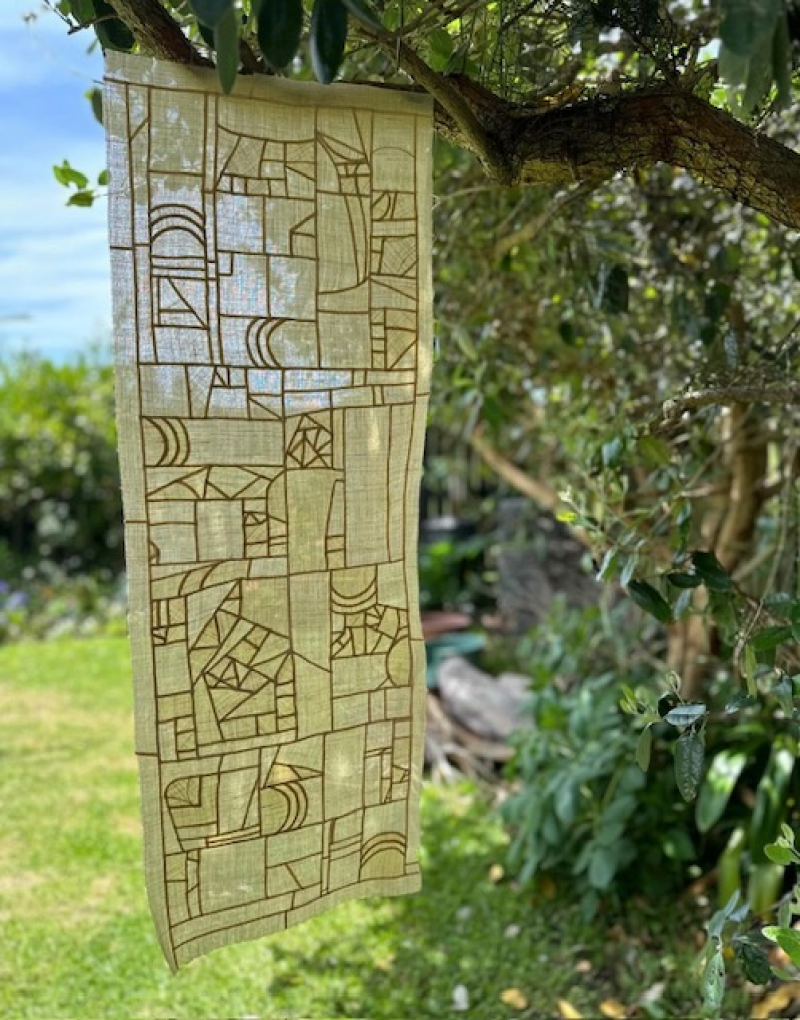
Sambe Jogakbo: Northern Child study I by Moonhee Han
Connecting cultures by Alessia Belsito-Riera
Inspired by the discovery that Korean bojagi and Māori tukutuku artworks share similar geometric designs and linear forms, artists Tiki Coveny, Yon Yi Sohn, Moonhee Han, and Eun Jung Jang come together in Hono Aho – Connecting Lines at Pātaka Art + Museum until the 28th of April. In their specificity and distinctness, the embroidery, paintings, and latticework on display explore the synergy between Māori and Korean cultural heritage and the hybridity of Aotearoa’s diverse communities.
What differences and similarities have emerged between bojagi and tukutuku?
Moonhee Han: Bojagi is a traditional cloth from Korea that is used for carrying, wrapping, or covering items. Jogakbo is created from scraps of fabric left over from making hanbok, Korea’s national costume. The similarities between Korean bojagi (or jogakbo) and Māori tukutuku lie in their utilisation of geometric or repeated patterns. However, a significant difference is that tukutuku patterns serve as a form of visual language for storytelling, whereas jogakbo patterns are created from leftover fabric scraps without such narrative or symbolic meaning.
Yon Yi: While I was studying a Māori Art and Design course at Massey, I realised that there were lots of similarities between traditional Korean and Māori culture, including worldview and symbolism that are expressed in colours and patterns. Both bojagi and tukutuku are produced with labour-intensive, time-invested methods – hand stitching bojagi pieces and manually weaving tukutuku patterns requires lots of time, endeavour, precision, and designing.
What traditions do these artforms hold?
Moonhee: The Korean art of bojagi, particularly jogakbo, embodies the values of humility and thriftiness that our ancestors have cherished. More than just practical tools for wrapping and carrying items, jogakbo is a vibrant showcase of creativity, turning leftover fabric scraps into beautiful, useful items. This approach to upcycling aligns with contemporary environmental values, emphasising sustainability.
Yon: Jogakbo’s striking patterns and harmonious colour blends also carry significant cultural meaning, reflecting the harmony and balance of Korean culture. Every stitch and fold tells a story, connecting to broader themes of community, spirituality, and identity. Delving into jogakbo traditions provides insight into the values shaping Korean culture, enhancing our respect for our heritage, and underlining the importance of sustainability and thoughtfulness in today’s world.
What do you hope viewers take away from the exhibition?
Moonhee: A newfound appreciation for the profound connection between my artworks and the wisdom inherent in our ancestral philosophy, which emphasises living in harmony with nature. Each piece has been crafted to integrate with the natural elements of light and space, serving to convey the timeless message that our predecessors valued coexistence and mutual respect with nature over attempts to dominate or control it.
Yon: We hope that viewers would have an opportunity to appreciate a cultural hybridity among diverse communities in Aotearoa New Zealand – just like how small and fragmented elements of bojagi or tukutuku reach a wholesome, beautiful, and completed work in the end.
View more articles from:
« Issue 217, April 9, 2024

